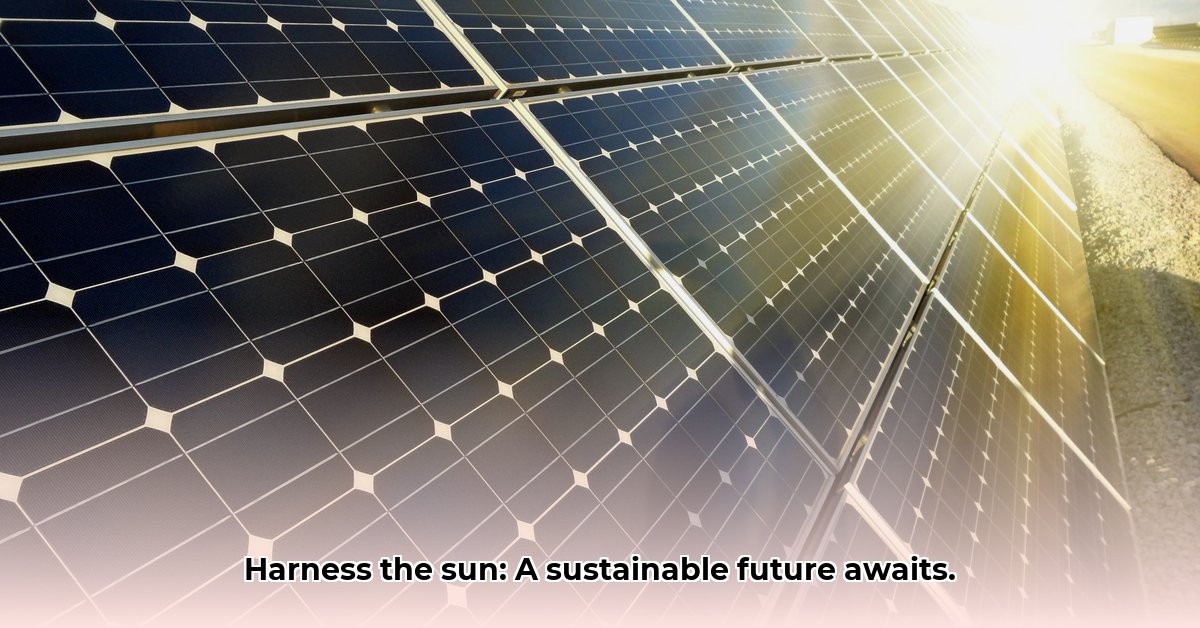Let’s talk solar power! This isn’t your average science lesson; we’re diving deep into how the sun can help save the planet. We’ll cover the different ways we harness solar energy – from those rooftop panels to clever building designs – and explain the science behind it all in plain English. You’ll learn about the environmental benefits, the costs, and the challenges we still face. We’ll look at the latest tech, explore how much it actually costs (and how to save money!), and even check out some real-world examples. By the end, you’ll not only understand solar energy, you’ll be ready to discuss it confidently in your AP Environmental Science class, and maybe even make a difference in the world. Learn about solar energy storage.
Solar Energy AP Environmental Science: Solutions for a Sustainable Future
Harnessing the sun’s power – it sounds simple, right? But the world of solar energy, a renewable energy source, is surprisingly complex and fascinating, a critical topic in AP Environmental Science. Let’s explore how we can use sunlight to create a cleaner, more sustainable future.
Understanding Solar Energy Systems: More Than Just Solar Panels
When we talk about solar energy, we’re not just talking about those rooftop panels; it’s a whole new world of renewable resources. There are actually three main ways we capture the sun’s energy, each with its own unique approach:
-
Photovoltaic (PV) Systems: These are the most common type – the solar panels you see on rooftops and in large-scale solar farms. These panels use special semiconductor materials that convert sunlight directly into electricity via the photovoltaic effect. Think of it like this: photons from sunlight strike the panel, exciting electrons within the material and creating a flow of electrical current. Scientists are constantly improving these panels, making them more efficient and less expensive, meaning we can generate more power from smaller areas. This is crucial for minimizing the land used by large solar farms, which is a big concern for environmentalists. Advancements in thin-film solar cells, for instance, offer greater flexibility and lower manufacturing costs compared to traditional silicon-based panels.
-
Active Solar Systems: These systems use mechanical and electrical equipment to collect and distribute solar heat. This isn’t about generating electricity directly from sunlight. Instead imagine solar collectors, often flat panels filled with a heat-absorbing fluid (like water or antifreeze). These collectors are strategically placed to maximize sun exposure. Then, pumps and fans circulate that heated fluid to warm a building, heat water for domestic use, or even drive industrial processes. While these systems are reliable for heating, they require more infrastructure and regular maintenance than passive systems. Examples include solar water heaters and solar air heating systems.
-
Passive Solar Systems: This is where clever design truly shines! Passive solar systems use architectural features to harness the sun’s energy without any mechanical components. For example, a building might be designed to maximize sunlight in winter to keep it warm, while strategically placed windows and overhangs can shade the building during summer. It’s all about creating a natural, eco-friendly heating and cooling system through smart building design, saving you power. This involves careful orientation of the building, insulation, thermal mass (materials that store heat, like concrete or brick), and reflective surfaces. South-facing windows (in the Northern Hemisphere) are a key element, allowing sunlight to penetrate during the winter when the sun is lower in the sky.
Weighing the Pros and Cons: A Balanced Look at Solar Power
Solar energy, like any technology, presents both advantages and disadvantages. Let’s take an objective look at both sides:
Advantages of Solar Energy:
-
Cleaner Energy: Solar power drastically reduces our reliance on fossil fuels, helping to create a greener environment. This significantly lowers greenhouse gas emissions, combating climate change. Solar energy systems produce minimal air and water pollution during operation. The sun’s energy helps us reduce our carbon footprint dramatically. By displacing fossil fuel-based electricity generation, solar power also reduces the emission of harmful pollutants like sulfur dioxide and nitrogen oxides, improving air quality and public health.
-
Increased Energy Independence: Solar energy allows homes, businesses, and even entire nations to generate their own electricity. This reduces dependence on large power grids and imported fossil fuels, enhancing energy security. Distributed solar generation, where solar panels are installed on homes and businesses, also reduces the strain on the electricity grid and increases resilience to power outages. It provides a new level of self-sufficiency.
-
Long-Term Cost Savings: While the initial investment might seem high, solar panels have a long lifespan, often 25-30 years or more. Over time, owners usually recoup their investment by reducing their electricity bills, and in some cases, selling excess electricity back to the grid through net metering programs. Think of it as a long-term investment that pays off. The levelized cost of energy (LCOE) for solar power has decreased dramatically in recent years, making it increasingly competitive with traditional energy sources.
Disadvantages of Solar Energy:
-
Intermittency: The sun isn’t always shining, which is the biggest challenge with solar power. Solar energy generation depends on sunlight availability, which varies depending on the time of day, weather conditions, and geographic location. This means solar energy is an intermittent resource, meaning that its availability fluctuates. While battery technology is improving, it’s still a significant hurdle. Smart grids and energy storage solutions are crucial for integrating solar power into the electricity grid and ensuring a reliable power supply.
-
High Initial Costs: The upfront cost of purchasing and installing solar panels can be a barrier to entry for many people. However, government incentives, financing options, and decreasing panel prices are gradually making it more accessible. Lease programs and power purchase agreements (PPAs) allow homeowners and businesses to use solar power without a large upfront investment.
-
Land Use: Large-scale solar farms do require significant land, potentially impacting ecosystems and competing with other land uses, such as agriculture. Careful planning and consideration of environmental impacts during site selection are essential. Integrating solar power into the built environment, such as installing solar panels on rooftops and parking structures, can reduce land use impacts.
-
Manufacturing and Disposal: The production and eventual disposal of solar panels have their own environmental consequences. The manufacturing process requires energy and resources, and some solar panels contain hazardous materials. However, recycling technologies are being developed to minimize waste and recover valuable materials. Ongoing research is focused on creating more sustainable manufacturing processes, reducing the use of hazardous materials, and improving recycling methods. The environmental impact of solar panel manufacturing and disposal is generally lower than that of fossil fuel-based energy production.
Technological Advancements: The Future is Bright (and Sunny!)
The field of solar energy is constantly evolving, providing cleaner electricity. Scientists and engineers are continually improving the technology in several key areas:
-
Improved Efficiency: Researchers are developing new materials and techniques to increase the efficiency of solar panels, allowing them to generate more electricity from the same amount of sunlight. This is a constant drive to improve the technology and make better use of available sunlight. Higher efficiency solar panels reduce the amount of land required for solar farms and lower the overall cost of solar power.
-
New Materials: Exciting new materials, like perovskites and organic solar cells, offer the potential for even more efficient and cost-effective solar cells. These are still under development, but they hold significant promise for the future of solar energy. These materials could potentially be manufactured at lower costs and with less energy than traditional silicon-based solar cells.
-
Energy Storage Solutions: Battery technology is becoming increasingly sophisticated and cheaper. Lithium-ion batteries are currently the most common type of battery used for solar energy storage, but other technologies, such as flow batteries and solid-state batteries, are also being developed. This is key to addressing the intermittency issue, allowing us to store solar energy generated during the day and use it at night or on cloudy days. Storage is a crucial element in making solar energy reliable.
-
Smart Grids: Smart grids use advanced communication and control technologies to optimize the distribution of electricity and integrate renewable energy sources more effectively. Smart grids can help to balance the supply and demand of electricity, reducing the need for energy storage and improving the reliability of the power grid.
Environmental Impact: A Lifecycle Analysis
A complete environmental assessment of solar energy requires considering its entire lifecycle – from extracting raw materials to manufacturing, operation, and eventual disposal. This lifecycle assessment allows us to evaluate all environmental impacts, both positive and negative. While solar energy is significantly cleaner than fossil fuels, it’s important to understand the potential environmental consequences at each stage and to seek ways to minimize them. This includes reducing waste during manufacturing, ensuring responsible sourcing of materials, and developing effective recycling methods.
-
Material Extraction and Manufacturing: The extraction of raw materials, such as silicon and rare earth minerals, for solar panel production can have environmental impacts, including habitat destruction and water pollution. The manufacturing process also requires energy and can generate greenhouse gas emissions.
-
Operation: Solar energy systems produce minimal air and water pollution during operation. However, large-scale solar farms can have land use impacts, potentially affecting wildlife habitats and ecosystems.
-
Disposal: The disposal of solar panels at the end of their lifespan can pose environmental challenges due to the presence of hazardous materials, such as lead and cadmium, in some types of panels, although these are increasingly rare. Recycling technologies are being developed to recover valuable materials from solar panels and minimize waste.
Economic Viability: The Numbers Tell the Story
The economic viability of solar power depends on several factors, including its overall price in relation to traditional sources of energy, government incentives such as green energy
- Hydro Extrusions USA Leads North American Aluminum Profile Solutions - December 28, 2025
- Hydro North America Leads Aluminum Extrusion Solutions Across Diverse Industries - December 27, 2025
- Hydro Extrusion North America Provides Custom Solutions Across Diverse - December 26, 2025
















